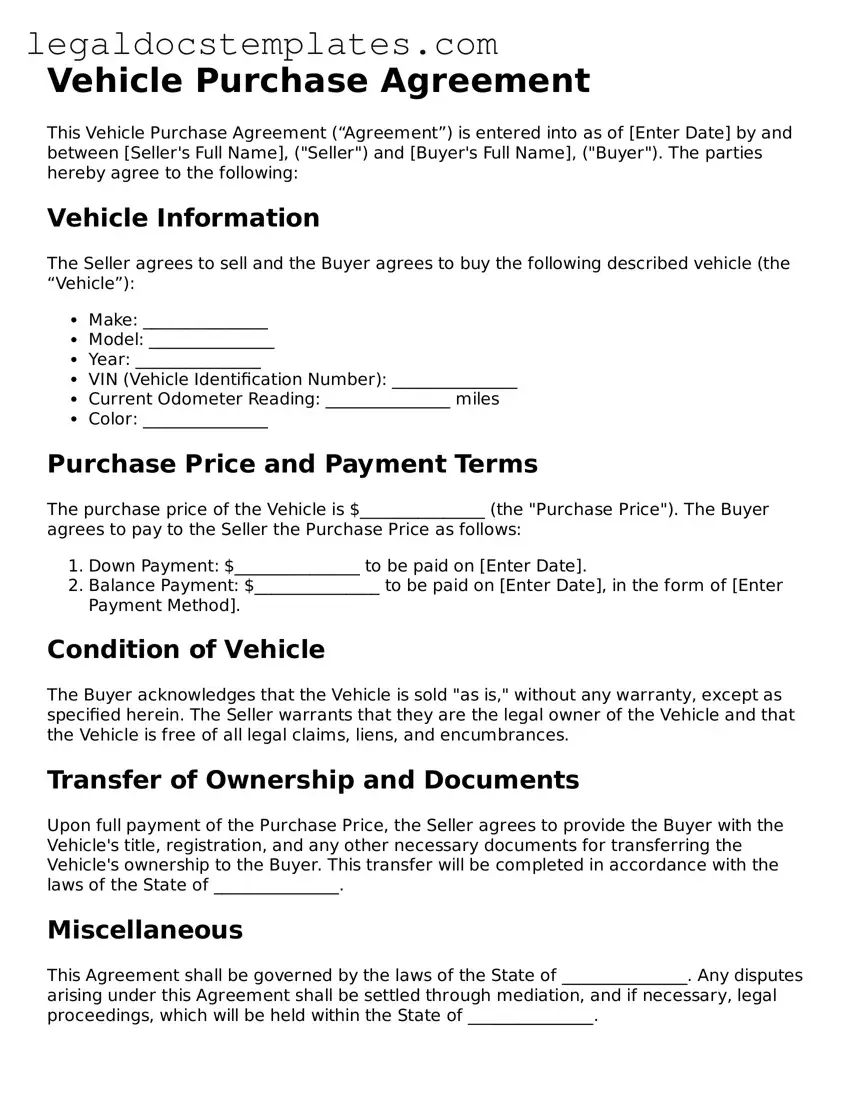The Bill of Sale is closely related to the Vehicle Purchase Agreement in its purpose and content, acting as a legally binding document that records the sale and transfer of an asset from a seller to a buyer. Like the Vehicle Purchase Agreement, it details the terms of the sale, including the parties involved, the sale date, and the specifics of the item sold — in this case, a vehicle — ensuring that the ownership transition is recognized by law. However, the Bill of Sale is often more concise and focuses on the transaction's completion rather than the conditions leading up to the sale.
A Lease Agreement shares similarities with a Vehicle Purchase Agreement, primarily in its function of outlining the terms between two parties, but it pertains to renting property rather than buying. It includes details on payment terms, property descriptions, and the responsibilities of each party, akin to how a Vehicle Purchase Agreement specifies payment schedules, vehicle details, and the obligations of the buyer and seller. Both documents serve to protect the interests of the parties involved by legally formalizing the agreement terms.
The Warranty Deed, while commonly used in real estate transactions, parallels the Vehicle Purchase Agreement in its guarantee about the status of the title being transferred. It assures the buyer that the property (in the case of vehicles, the vehicle) is free from liens or claims, similar to how a Vehicle Purchase Agreement might include clauses regarding the vehicle's clear title and any warranties or guarantees. The document is critical in providing peace of mind and legal protection to the buyer.
A Promissory Note, relating to the financing aspect of purchasing, is an agreement for one party to pay another a specific sum of money, often with interest, by a certain date, which can be part of a Vehicle Purchase Agreement when the buying price is not paid upfront. This similarity lies in the documentation of financial obligations between parties, ensuring there is a legal recourse if the terms of payment are not met, thus safeguarding the interests of the seller or financier.
Loan Agreements are akin to Vehicle Purchase Agreements when vehicles are financed through loans. They detail the loan's terms, including interest rates, repayment schedule, and consequences of default. These agreements ensure both the lender and borrower understand their rights and obligations, similar to how Vehicle Purchase Agreements lay out the terms of the vehicle sale to ensure fairness and clarity in the transaction.
The Non-Disclosure Agreement (NDA) shares a fundamental similarity with a Vehicle Purchase Agreement in its emphasis on confidentiality, though NDAs are primarily used to protect sensitive information. When personal or sensitive data is exchanged during a vehicle purchase, elements of an NDA may be embedded within the Vehicle Purchase Agreement to safeguard the parties' privacy, making clear legal boundaries around the dissemination of shared information.
The Employment Contract, while focused on employer-employee relationships, is similar to a Vehicle Purchase Agreement in its outline of terms agreed upon by parties entering into a binding relationship. Although one pertains to the sale of a vehicle and the other to terms of employment, both include detailed descriptions of the agreement's scope, expectations, and obligations of each party, thereby providing a structured framework for the commitment.
An Equipment Lease Agreement, for the leasing of machinery or equipment, parallels the Vehicle Purchase Agreement in transactions where vehicles are leased rather than purchased. Both documents detail the terms under which the lessor allows the lessee to use the asset, including payment schedules, maintenance responsibilities, and duration of the lease, ensuring both parties are legally protected during the lease term.
Finally, the Sales Contract, a broad agreement used in various transactions, from real estate to personal property, is akin to the Vehicle Purchase Agreement in that it legally formalizes the sale and purchase terms. Both documents serve as a detailed record of the agreement, including price, conditions of sale, and warranties, thereby ensuring that the expectations and obligations of both buyer and seller are clearly defined and legally enforceable.
